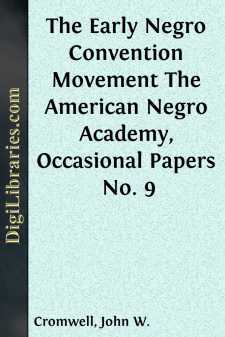Categories
- Antiques & Collectibles 13
- Architecture 36
- Art 48
- Bibles 22
- Biography & Autobiography 813
- Body, Mind & Spirit 142
- Business & Economics 28
- Children's Books 15
- Children's Fiction 12
- Computers 4
- Cooking 94
- Crafts & Hobbies 4
- Drama 346
- Education 46
- Family & Relationships 57
- Fiction 11828
- Games 19
- Gardening 17
- Health & Fitness 34
- History 1377
- House & Home 1
- Humor 147
- Juvenile Fiction 1873
- Juvenile Nonfiction 202
- Language Arts & Disciplines 88
- Law 16
- Literary Collections 686
- Literary Criticism 179
- Mathematics 13
- Medical 41
- Music 40
- Nature 179
- Non-Classifiable 1768
- Performing Arts 7
- Periodicals 1453
- Philosophy 64
- Photography 2
- Poetry 896
- Political Science 203
- Psychology 42
- Reference 154
- Religion 513
- Science 126
- Self-Help 84
- Social Science 81
- Sports & Recreation 34
- Study Aids 3
- Technology & Engineering 59
- Transportation 23
- Travel 463
- True Crime 29
The Early Negro Convention Movement The American Negro Academy, Occasional Papers No. 9
by: John W. Cromwell
Description:
Excerpt
The Early Negro Convention Movement.
With the period immediately following the Second War with Great Britain, begins a series of events which indicate a purpose of the nation to make the condition of the free man of color an inferior status socially and politically. That this was resisted at every step, revealed the national aim and purpose.
The protest against prescription in the Church which had asserted itself in several instances as at St. James P. E. and Bethel in Philadelphia, Zion in New York, culminated in the organization of two independent denominations—in 1816 at Philadelphia, in 1820 at New York.
The American Colonization Society was organized in 1816 with the hidden purpose of strengthening slavery by ridding the country of its free black population. In 1820 the passage of the Missouri Compromise permitted the westward extension of slavery and as far north as 36° 30′.
Local legislation, harmonizing with this national action against extending the domain of freedom and making the country undesirable for the colored freeman, followed. Two years after the enactment of the compromise, “the martyrs of 1822” went bravely and heroically to their fate in South Carolina. In 1827, the Empire State completed its work of emancipation of the slave began 28 years before, and saw the birth of “Freedom’s Journal,” the first Negro newspaper within the limits of the United States, edited by John B. Russwurm and Samuel E. Cornish. In 1831, Virginia was convulsed and the entire Southland shocked by the Insurrection of Nat. Turner. In the State of Ohio along the Kentucky border, the feeling against the free Negro had become acute. Mobs occurred, blood was shed and the people were compelled to look to some spot where they could abide in peace.
It was in these stirring times that the Convention movement which means the marshalling of the moral forces within the Negro came into existence. The forces which it evoked were conserved and correlated until the dynamics of Civil Revolution had wrought desolation and destruction far and wide, sweeping away forever what had been a basis of the social and political strength of the Nation.
Prior to this time, there had been a local convention held in Philadelphia, January, 1817, to protest against the action of the American Colonization Society that had been organized to remove systematically from this country all the free colored people in the United States. A glance at the list of the officers of this, the pioneer deliberative convention of colored people of which we have as yet any date, shows that the men who led in this meeting as in the movement of which this paper is a study, were among the foremost colored citizens whose names have come down to us from that distant past. James Forten was President, and Russell Parrott, the assistant to Absalom Jones at St. Thomas, P. E. Church, was the Secretary. Prominent also in this anti-colonization convention, were Absalom Jones, Richard Allen, Robert Douglass, Francis Perkins, John Gloucester—the first settled pastor of a colored Presbyterian Church—Robert Gordon, James Johnson, Quanmany Clarkson, John Summersett and Randall Shepherd....


